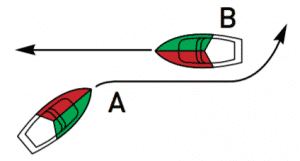Rules of the Road
The Collision Regulations set out right-of-way rules, often referred to as the “rules of the road”, to help boaters determine who has the right of way; that is, which vessel maintains its course and speed (referred to as the stand-on vessel), and which vessel gives way (termed the give-way vessel).
This is not just a way to be polite – it is the law, which applies to every vessel on all navigable waterways – from canoes to supertankers. All vessel operators are obligated to take all necessary steps to avoid a collision. Know the “rules of the road” and boat by them!
Failure to comply with these regulations can result in fines, imprisonment, or both.
Definitions Relevant to Navigation Rules

Stand-on vessel (B) is the vessel that maintains course while keeping a lookout to be sure that the other boat gives way.
If it becomes apparent that the give-way vessel is not altering course, then the stand-on vessel must take early and substantial action to avoid collision.
Give-way vessel (A) is the vessel that is required to keep out of the way of another vessel. Any alteration of course and/or speed to avoid collision shall, if the circumstances of the case admit, be large enough to be readily apparent to another vessel observing visually or by radar. A succession of small alterations of course and/or speed should be avoided.

